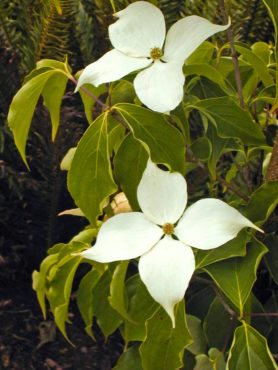
When the Kousa dogwoods are in bloom from May to June, the world takes notice. This region needs to turn away from the popular, prone-to-disease, ornamental cherry trees and turn to some great trees such as the Cornus kousa. Imagine walking down a dogwood-lined street when these most-elegant species are in bloom. It would be a horticulture dreamscape, turning a West Sound neighborhood or town into a floral wonderland for three to four weeks out of the year.
People adore dogwood flowers and form. Artists paint them on canvases and homeowners plant them in gardens. Considered a four-season plant, Cornus kousa is a broadly conical, deciduous tree. When the flowers swing into full showoff mode, the trees smother their branches with large, star-like flowers. The showiest part is not the flowers, however. Four large, floral bracts commonly mistaken for petals surround tiny, inconspicuous, yellow-green flowers. It is all about the bracts for these Asian beauties.
Yet the beauty does not stop once the flowers fade. Considered by enthusiasts as one of the most desirable trees for Western gardens, kousa dogwood provides four seasons of interest in the garden. Its cultivars have some of the largest bracts and fruit in the genus. Its dark-green leaves with wavy margins are easy to identify as dogwood. The leaves carry the plant through summer, providing shade during the dog days of summer.
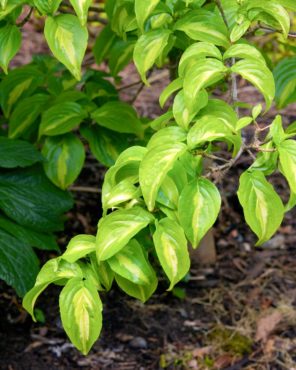
The dogwood gives another seasonal show in autumn, when the leaves turn a glorious, deep crimson to purple and the strawberry-red fruit dangles from the branches. Once the leaves and fruits fall, it is the bark’s turn to show off its mottled, exfoliating, tan-and-gray bark.
In the history of the Earth, the genus Cornus has been around a long time, dating back to the time when dinosaurs ruled the world. Many species in the genus populated the Northern Hemisphere and Cornus kousa grew in Korea, China and Japan.
The name Cornus comes from the Latin word cornu, which means horn. Some acknowledge that the name is a tribute to the density and strength of the wood. The epithet kousa is the Japanese word for dogwood.
The common name dogwood has nothing to do with dogs. Europeans originally called the plants whippletrees, which evolved into dog-trees and eventually changed to dogwood. Some language experts believe the common name is attributed to a misspelling of dagwood — primitive weapons such as darts and arrow shafts made from a hardwood called dags.
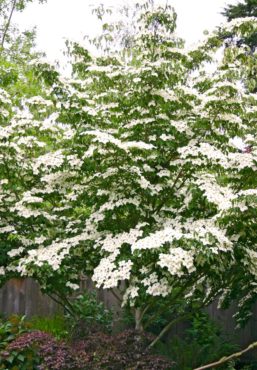
Crosses with other species produced many fine garden-worthy specimens. The species will reach heights of 20 to 30 feet and 15 to 30 feet wide, although some cultivars are smaller in stature.
“It is always encouraging to find one’s plants reproducing themselves naturally, as it shows they made themselves at home,” British gardener Norman Hadden once said. Growing our native Pacific dogwood, Cornus nuttallii, in his English garden in the late 1950s, he spotted a seedling growing under it. Hadden speculated the small plant was a cross of C. nuttallii and a C. kousa that grew nearby. The semi-evergreen shrub bloomed profusely in early summer, with star-shaped flowers opening white and maturing pink. The shrub covered itself in red fruits in the fall.
In 1968, the tree exhibited under the name Cornus ‘Porlock.’ Meanwhile, Hadden found another notable seedling, which later exhibited as C. ‘Norman Hadden.’ Both trees were similar, making botanists question their origins. Neither variety came from the Northwest native dogwood as once thought. Both varieties’ parentage came from C. capitata and C. kousa.
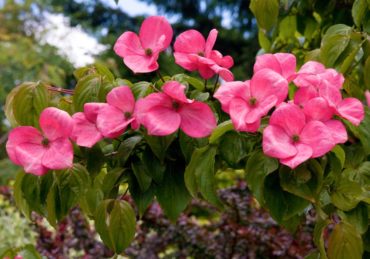
Besides the common name kousa dogwood, the tree goes by Chinese dogwood, Japanese dogwood, Korean dogwood, strawberry tree and yang-mei (Chinese).
Cornus kousa is a dweller of moist, fertile forests, yet the tree will grow in full sun to partial shade. In a garden setting, they will thrive in a humus-rich, moist, well-drained, fertile soil with an acidic to neutral soil pH.
Propagate the species by sowing seed in an outside seedbed in autumn. Root softwood cuttings in summer and hardwood cuttings in autumn.
Diseases
Cornus kousa is relatively free of disease. The Asian dogwood is spared from outbreaks of Discula spp., an organism responsible for the dreaded dogwood anthracnose. The disease plagues the Northwest native C. nuttallii and East Coast native C. florida.
With the exception of Cornus kousa var chinensis that is highly susceptible to the disease, C. kousa has few outbreaks and the disease remains as foliar lesions, which does not kill the species or cultivars.
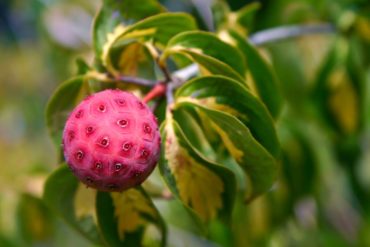
Pruning
Because dogwood trees throw water sprouts easily, pruning is a tricky business. Prune too much, and your tree will throw numerous water sprouts from each cut. When planning your garden, place your tree where it will reach its potential full size without having to prune it.
Noteworthy Crosses and Cultivars
- Rutger University bred some noteworthy crosses with C. kousa and C. florida that are disease free as well as handsome specimens — Cornus x ‘Rutban’ (sold under trademark Aurora), C. x ‘Rutdan’ (Celestial or Galaxy), C. x ‘Rutcan’ (Constellation), C. x ‘Rutlan’ (Ruth Ellen), C. x ‘Rutfan’ (Stardust), C. x ‘Rutgan’ (Stellar Pink).
- ‘Little Poncho’ is a dwarf kousa that reaches 8-10 feet tall, a choice alternative for small gardens.
- ‘Milky Way,’ a popular cultivar with a broad bushy form, produces a copious amount of flowers in the spring, followed by fruit later in the growing season.
- ‘Wolf Eye’ is a variegated cultivar with green leaves and creamy-white, wavy margins and pink-to-red autumn color. Grow this for both the beautiful foliage and flowers, and small stature of 6 feet tall and wide.
- ‘Beni Fuji,’ with narrow red bracts, has the darkest hue of all the kousa cultivars.
- ‘Moonbeam’ has large, drooping bracts.
- ‘Big Apple’ is a large, spreading tree. The fruits are 1-1/4 to 1-1/2 inches across and the bracts are up to 5 inches across.
- ‘Radiant Rose’ is a stunner with pink flower bracts, red-tinted summer leaves and red fall leaves.
- ‘Miss Satomi’ is a spreading shrub, sometimes sold as ‘Satomi.’ Deep-pink bracts surround the flowers and are followed by rosy-pink fruit. Leaves turn rose-pink and purple in autumn.




























Comments